Lenovo Yoga 9i (14″, 2022) review
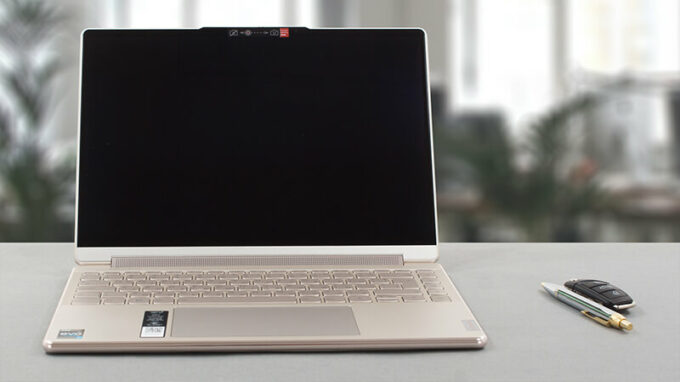 After the unsuccessful attempt to completely change the touchpad for good, Lenovo has diverted to a more orthodox approach with the new Yoga 9i (14″). However, this doesn’t mean that it has lost its bling.
After the unsuccessful attempt to completely change the touchpad for good, Lenovo has diverted to a more orthodox approach with the new Yoga 9i (14″). However, this doesn’t mean that it has lost its bling.
Instead, this machine is now more exquisite than it has ever been. But before we go there, you should know what to expect. For starters, there is the hardware that powers the notebook. Lenovo went for Intel in this case.
The 12th Gen processors offer three (major) groups, regarding the TDP – a 15W, 28W, and a 45W. The last one is usually reserved for gaming notebooks or ones that have room for adequate cooling. Respectively, the 15W is the safe bet – less heat, and better battery life, but also less performance.
Naturally, the 28W option comes in the middle, and it has the potential to run close to the 45W devices when it’s given enough power. And this is what the Yoga 9i (14″, 2022) is getting.
It is hard to imagine that this tiny package will be able to cool down properly, but it is still possible. We’ll bring our pitchforks just in case.
By the way, you get a choice of three displays – one WUXGA IPS panel, one 2.8K OLED with a 90Hz refresh rate, and a 4K OLED with a 60Hz refresh rate.
You can check the prices and configurations in our Specs System: https://laptopmedia.com/series/lenovo-yoga-9i-14-2022/
Contents
Specs Sheet
- HDD/SSD
- up to 2000GB SSD
- M.2 Slot
- 1x 2280 PCIe NVMe 4.0 x4 See photo
- RAM
- up to 16GB
- OS
- Windows 11 Pro, Windows 11 Home, Windows 10 Home
- Battery
- 75Wh
- Body material
- Aluminum
- Dimensions
- 318 x 230 x 15.25 mm (12.52" x 9.06" x 0.60")
- Weight
- 1.40 kg (3.1 lbs)
- Ports and connectivity
- 1x USB Type-A
- 3.2 Gen 1 (5 Gbps)
- 1x USB Type-C
- 3.2 Gen 2 (10 Gbps), Power Delivery (PD), DisplayPort
- 2x USB Type-C
- 4.0, Thunderbolt 4, Power Delivery (PD), DisplayPort
- Card reader
- Ethernet LAN
- Wi-Fi
- 802.11ax
- Bluetooth
- 5.2
- Audio jack
- 3.5mm Combo Jack
- Features
- Fingerprint reader
- Web camera
- FHD & IR
- Backlit keyboard
- Microphone
- Dual Array Microphone with Noise Cancellation
- Speakers
- 2x 3W Woofers + 2x 2W Front-Facing Tweeters, Dolby Atmos, Bowers & Wilkins
- Optical drive
- Security Lock slot
All Lenovo Yoga 9i (14″, 2022) configurations
What’s in the box?
Our configuration was paired with the mandatory paperwork, a 100W USB Type-C power adapter, as well as a stylish sleeve. You also might get a dedicated Lenovo Pen with your device.
Design and construction
Last year, Lenovo tried to set a trend with its invisible touchpad and glass palm rest area. The only other popular notebook that responded was Dell’s XPS 13 Plus 9320. Instead of investing more in an arguably dead-on-arrival technology, Lenovo decided to revert to a traditional design.
At least when it’s regarding the touchpad. The body, on the other hand, is arguably the most premium-looking we’ve ever seen from a laptop. Its base looks chrome-plated, resembling an abomination of an iPhone 11 and Buick Riviera.
Needless to say, the entire machine is made out of aluminum. Its display is covered by glass, which provides the lid with extra resilience. Both the base and the lid are incredibly tough and show almost zero flex when twisted. In terms of dimensions, we’re talking about a thickness of just 15.25mm, and weight of 1.40 kg for the OLED panel, and 1.50 kg for the IPS one.
This device’s lid can be opened with a single hand up until 90° when the hinges halt to switch their position. This is pretty common for convertibles. You can clearly see that the hinge cover is actually a speaker. Well, not the entirety of it, just two small portions, which house the 2W tweeters. There are two more in the base, but they are 3W woofers.
By the way, the display is surrounded by slim top and side bezels, and a pretty thick bottom one. Nevertheless, we see an IR face recognition scanner, a Full HD Web camera, and a privacy shutter up top.
This is paired with a fingerprint reader on the base. It has quite unusual location. One, that is pretty comfortable, though. Above it, you see an array of shortcut buttons. One of them toggles the performance preset, another helps you remove the background around you when you’re on camera. The next switches between sound profile presets, while the last one lets you choose between light and dark modes in Windows 11.
The keyboard, itself, is pretty comfortable. It has decent key travel and clicky feedback. In addition, you get a backlight. A bigger star of the show, expectedly, is the touchpad.
Its glass surface is super smooth, while the clicky mechanism allows for very fast navigation. In our view, the response is super fast. Its 80 by 135mm surface area is big enough to ride a skateboard too.
If you turn the laptop upside down, you will see the two speaker grills meant for the Woofers. Furthermore, there is a ventilation grill, which lets the fans draw cool air, while the hot air is exhausted through two vents on the back of the base.
Ports
On the left side, there is a USB Type-A 3.2 (Gen. 2) port, and two Thunderbolt 4 connectors. Then, on the right, you get an Audio jack, a USB Type-C 3.2 (Gen. 2) with Power Delivery and DisplayPort 1.4 output, as well as the power button.
Disassembly, upgrade options, and maintenance
To take this notebook apart, you first need to remove the back rubber foot. Then, undo the three Phillips-head screws it hides, as well as the six visible Torx-head screws. After that, pry the bottom panel with a plastic tool, and remove it from the chassis.
Inside, we find a 75Wh battery pack. It got us through about 7 hours of either Web browsing or video playback. To take it out, you need to undo 5 Phillips-head screws and unplug the battery connector from the motherboard.
Here, the memory can’t be upgraded, as it is soldered to the motherboard. You can find it in configurations with 8 or 16GB of LPDDR5 RAM, working at 5200 MHz. Storage-wise, there is one M.2 PCIe x4 slot for Gen 4 SSDs.
You can see that the cooling looks pretty capable with two heat pipes, two fans, and two heat sinks. Even the VRMs are being cooled.
Display quality
Lenovo Yoga 9i (14″, 2022) is equipped with a 90Hz OLED panel, LEN140WQ+ (LEN8A98). Its diagonal is 14.0-inch (35.5 cm), and the resolution – 2880 x 1800p. Additionally, the screen ratio is 16:10, the pixel density – 243 ppi, and their pitch – 0.1 x 0.1 mm. The screen can be considered Retina when viewed from at least 36 cm (from this distance, the average human eye can’t see the individual pixels).
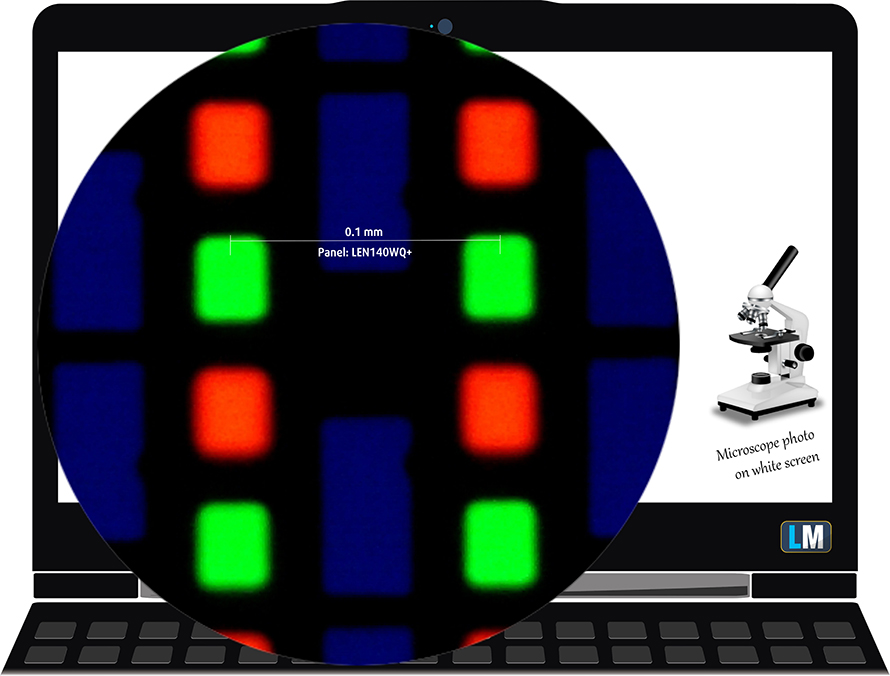
Viewing angles are comfortable. We offer images from different angles to evaluate the quality.

Also, a video with locked focus and exposure.
The maximum measured brightness is 399 nits (cd/m2) (HDR off) in the middle of the screen and 397 nits (cd/m2) as an average with a maximum deviation of only 2%. The Correlated Color Temperature on a white screen and at maximum brightness is 6300K – slightly warmer than the 6500K temperature for sRGB.
In the illustration below you can see how the display performs from a uniformity perspective.
Values of dE2000 over 4.0 should not occur, and this parameter is one of the first you should check if you intend to use the laptop for color-sensitive work (a maximum tolerance of 2.0 ). The contrast ratio here is incomparably better than that of the IPS and TN panels and is mathematically infinite.
To make sure we are on the same page, we would like to give you a little introduction to the sRGB color gamut and the Adobe RGB. To start, there’s the CIE 1976 Uniform Chromaticity Diagram that represents the visible specter of colors by the human eye, giving you a better perception of the color gamut coverage and the color accuracy.
Inside the black triangle, you will see the standard color gamut (sRGB) that is being used by millions of people on HDTV and on the web. As for the Adobe RGB, this is used in professional cameras, monitors, etc for printing. Basically, colors inside the black triangle are used by everyone and this is the essential part of the color quality and color accuracy of a mainstream notebook.
Still, we’ve included other color spaces like the famous DCI-P3 standard used by movie studios, as well as the digital UHD Rec.2020 standard. Rec.2020, however, is still a thing of the future and it’s difficult for today’s displays to cover that well. We’ve also included the so-called Michael Pointer gamut, or Pointer’s gamut, which represents the colors that naturally occur around us every day.
The yellow dotted line shows Lenovo Yoga 9i (14″, 2022)’s color gamut coverage.
Its display covers 100% of the sRGB/ITU-R BT.709 (web/HDTV standard) in CIE1976 and 100% of DCI-P3 providing a punchy and vibrant image (HDR off).
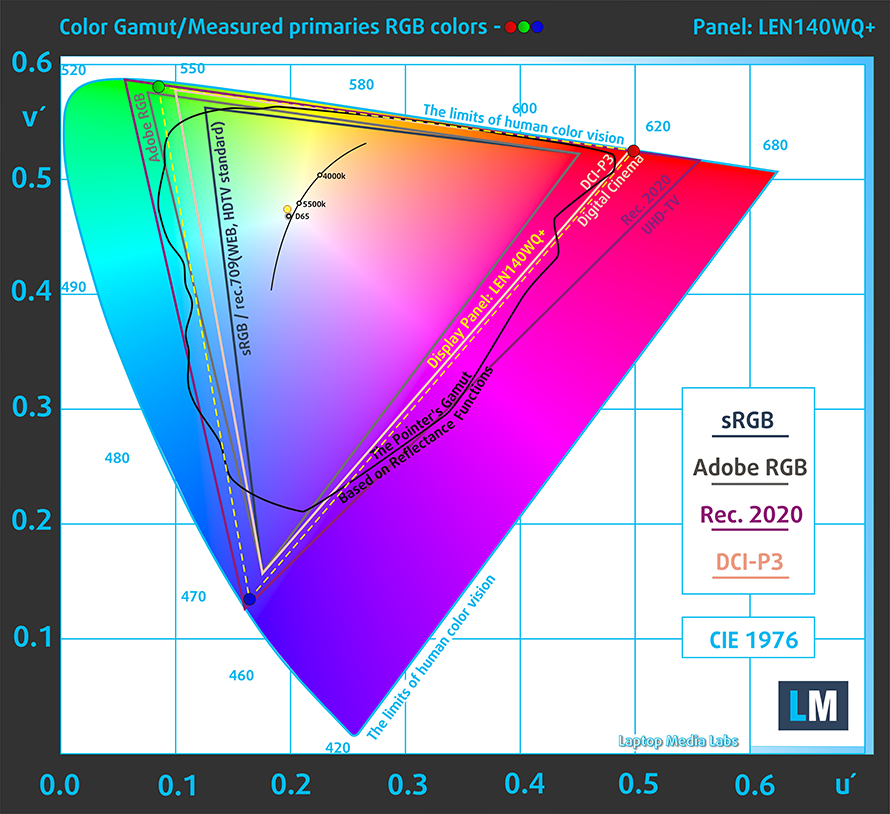
We tested the accuracy of the display with 24 commonly used colors like light and dark human skin, blue sky, green grass, orange, etc.
Below you can compare the scores of the Lenovo Yoga 9i (14″, 2022) against the P3-D65 standards (HDR off).
We also tested it in sRGB mode (HDR off).
The next figure shows how well the display is able to reproduce really dark parts of an image, which is essential when watching movies or playing games in low ambient light.
The left side of the image represents the display with stock settings, while the right one is with the “Gaming and Web Design” profile activated. On the horizontal axis, you will find the grayscale, and on the vertical axis – the luminance of the display. On the two graphs below you can easily check for yourself how your display handles the darkest nuances but keep in mind that this also depends on the settings of your current display, the calibration, the viewing angle, and the surrounding light conditions.
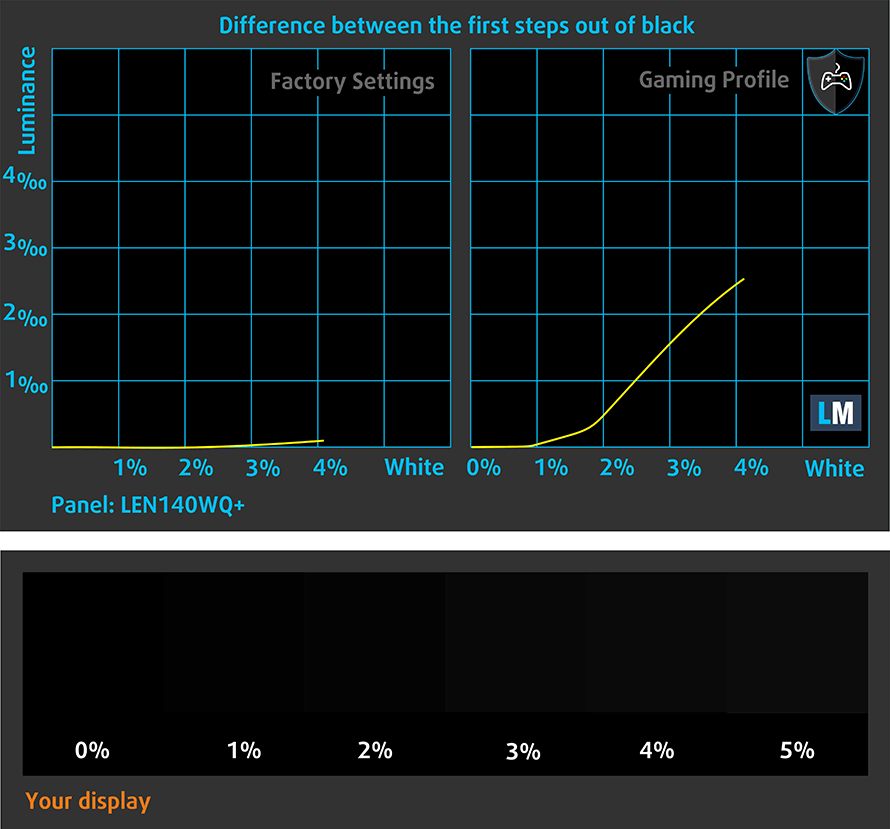
Response time (Gaming capabilities)
We test the reaction time of the pixels with the usual “black-to-white” and “white-to-black” method from 10% to 90% and vice versa.
We recorded Fall Time + Rise Time = 2 ms.
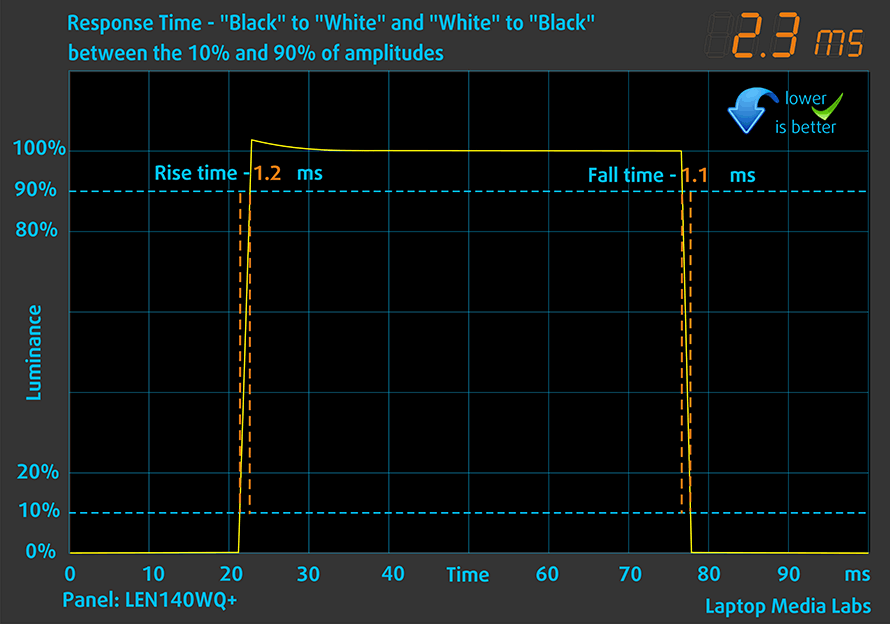
After that, we test the reaction time of the pixels with the usual “Gray-to-Gray” method from 50% White to 80% White and vice versa between 10% and 90% of the amplitude.
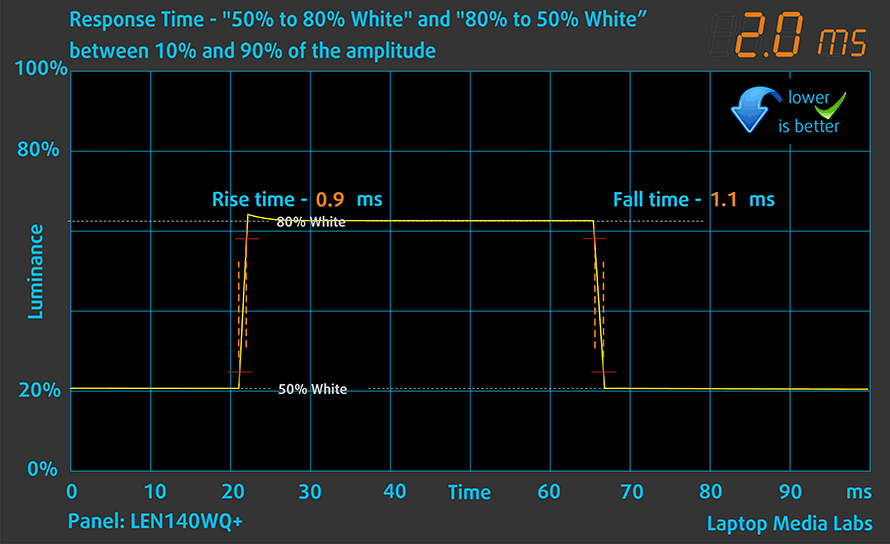
Health impact – PWM / Blue Light
PWM (Screen flickering)
Pulse-width modulation (PWM) is an easy way to control monitor brightness. When you lower the brightness, the light intensity is not lowered, but instead turned off and on by the electronics with a frequency indistinguishable to the human eye. In these light impulses, the light/no-light time ratio varies, while brightness remains unchanged, which is harmful to your eyes. You can read more about that in our dedicated article on PWM.
Unfortunately, Lenovo Yoga 9i (14″, 2022)’s panel uses low-frequency PWM for luminance adjustment up to 90 nits. Afterwards, we detected small pulsations, which makes the display generally safe in this aspect (after 90 nits).
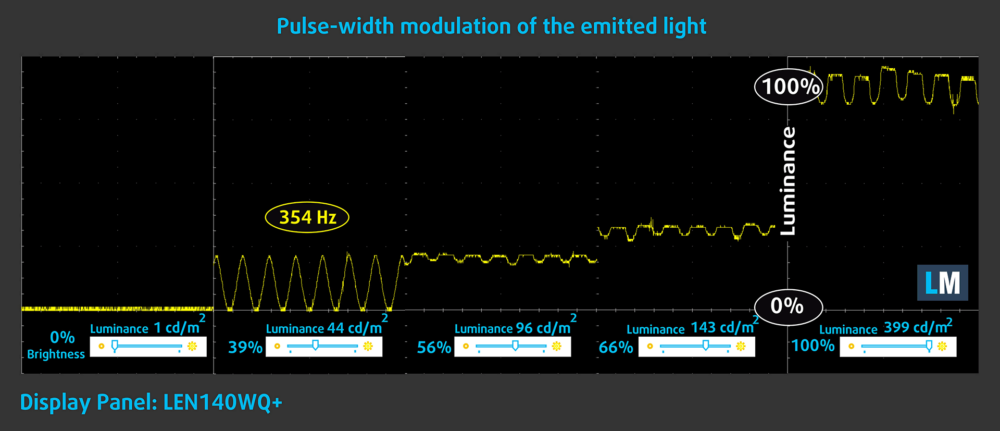
Blue light emissions
Installing our Health-Guard profile not only eliminates PWM but also reduces the harmful Blue Light emissions while keeping the colors of the screen perceptually accurate. If you’re not familiar with the Blue light, the TL;DR version is – emissions that negatively affect your eyes, skin, and your whole body. You can find more information about that in our dedicated article on Blue Light.
Gloss level measurement
Glossy-coated displays are sometimes inconvenient in high ambient light conditions. We show the level of reflection on the screen for the respective laptop when the display is turned off and the measurement angle is 60° (in this case, the result is 152 GU).
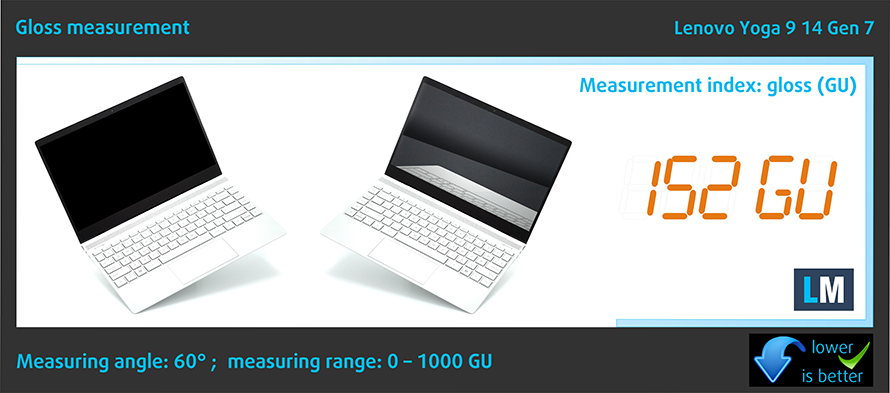
Buy our profiles
Since our profiles are tailored for each individual display model, this article and its respective profile package are meant for Lenovo Yoga 9i (14″, 2022) configurations with a 14.0″ LEN140WQ+ (LEN8A98) (2880 x 1800p) OLED panel.
*Should you have problems with downloading the purchased file, try using a different browser to open the link you’ll receive via e-mail. If the download target is a .php file instead of an archive, change the file extension to .zip or contact us at [email protected].
Read more about the profiles HERE.
In addition to receiving efficient and health-friendly profiles, by buying LaptopMedia's products you also support the development of our labs, where we test devices in order to produce the most objective reviews possible.

Office Work
Office Work should be used mostly by users who spend most of the time looking at pieces of text, tables or just surfing. This profile aims to deliver better distinctness and clarity by keeping a flat gamma curve (2.20), native color temperature and perceptually accurate colors.

Design and Gaming
This profile is aimed at designers who work with colors professionally, and for games and movies as well. Design and Gaming takes display panels to their limits, making them as accurate as possible in the sRGB IEC61966-2-1 standard for Web and HDTV, at white point D65.

Health-Guard
Health-Guard eliminates the harmful Pulse-Width Modulation (PWM) and reduces the negative Blue Light which affects our eyes and body. Since it’s custom tailored for every panel, it manages to keep the colors perceptually accurate. Health-Guard simulates paper so the pressure on the eyes is greatly reduced.
Get all 3 profiles with 33% discount
Sound
Lenovo Yoga 9i (14″, 2022)’s Bower & Wilkins speakers produce a sound of very good quality. In addition, its low, mid, and high tones are clear of deviations.
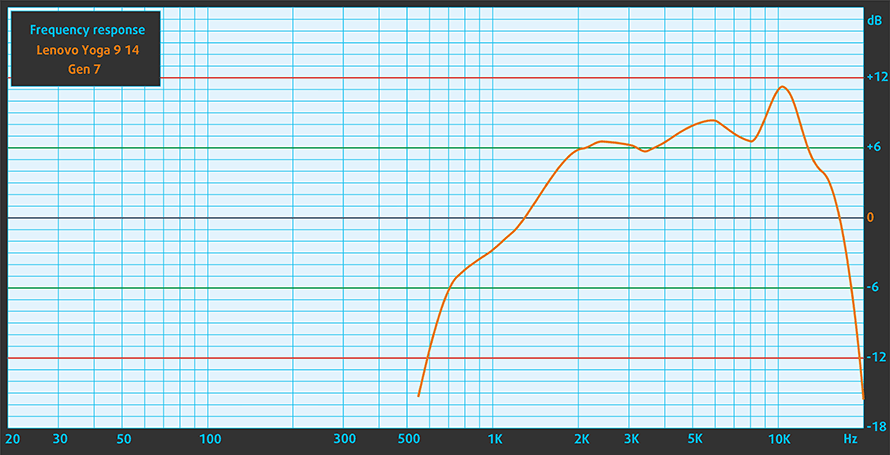
Drivers
All drivers and utilities for this notebook can be found here: https://pcsupport.lenovo.com/us/en/products/laptops-and-netbooks/yoga-series/yoga-9-14iap7/downloads/driver-list
Battery
Now, we conduct the battery tests with the Windows Better performance setting turned on, screen brightness adjusted to 120 nits, and all other programs turned off except for the one we are testing the notebook with. This machine has a 75Wh battery pack. It lasts for 7 hours and 13 minutes of Web browsing, or 6 hours and 56 minutes of video playback.
In order to simulate real-life conditions, we used our own script for automatic web browsing through over 70 websites.
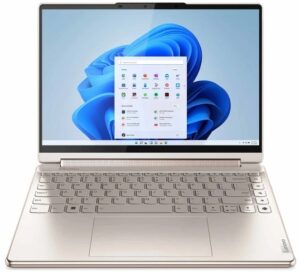
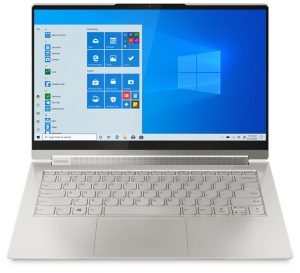
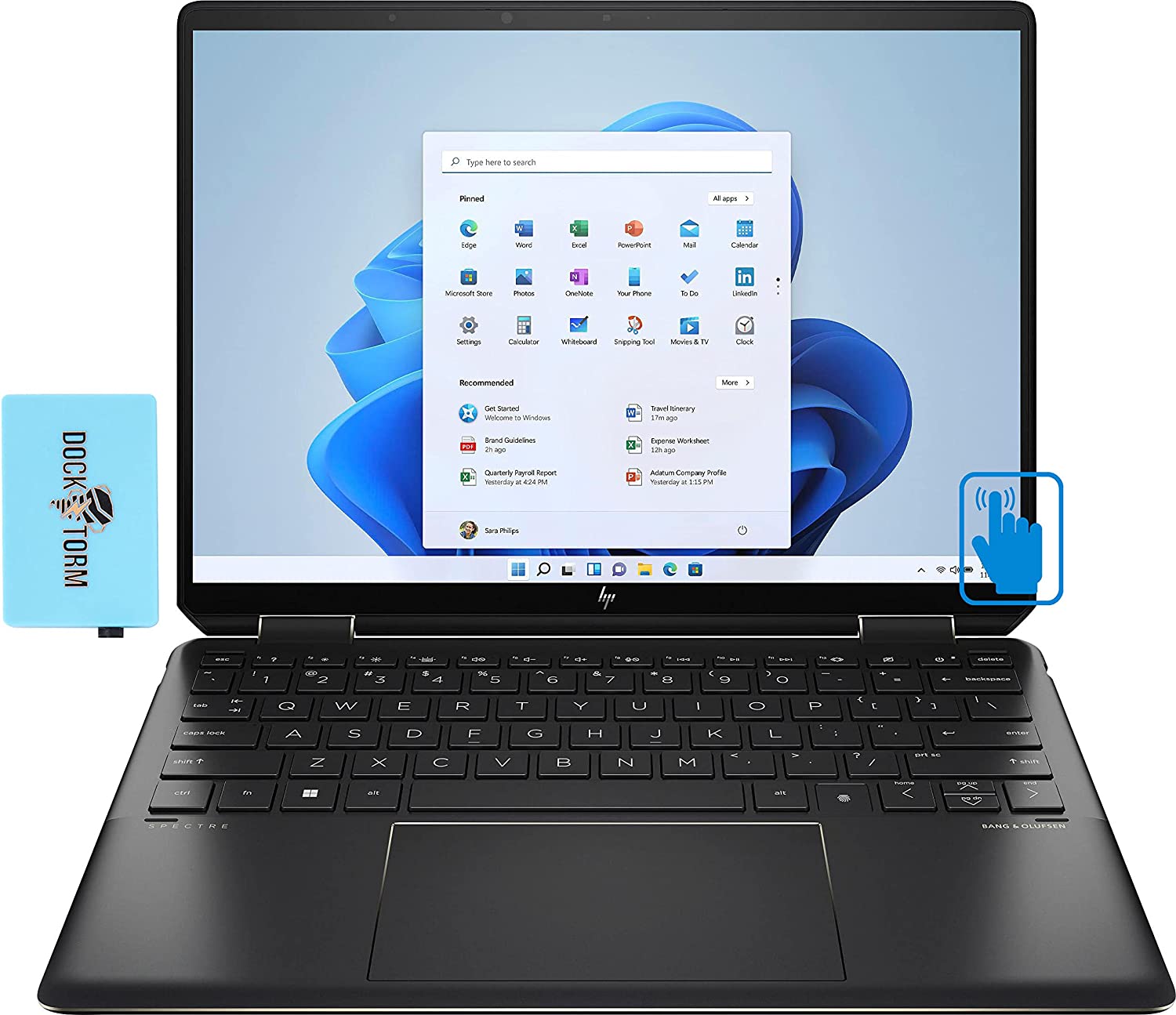
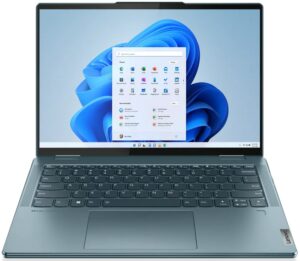

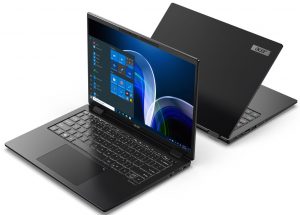
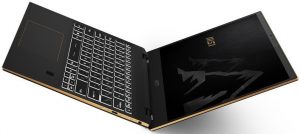
For every test like this, we use the same video in HD.







CPU options
You can find this device equipped with the Core i5-1240P, Core i7-1260P, or Core i7-1280P.
Results are from the Cinebench R23 CPU test (the higher the score, the better)
Results are from our Photoshop benchmark test (the lower the score, the better)
GPU options
Here, the graphics card is embedded in the CPU. It is the Intel Iris Xe Graphics G7.
Results are from the 3DMark: Time Spy (Graphics) benchmark (higher the score, the better)
Results are from the 3DMark: Fire Strike (Graphics) benchmark (higher the score, the better)
Results are from the 3DMark: Wild Life benchmark (higher the score, the better)
Results are from the Unigine Superposition benchmark (higher the score, the better)
Gaming tests

| CS:GO | HD 1080p, Low (Check settings) | HD 1080p, Medium (Check settings) | HD 1080p, MAX (Check settings) |
|---|---|---|---|
| Average FPS | 175 fps | 141 fps | 87 fps |

| DOTA 2 | HD 1080p, Low (Check settings) | HD 1080p, Normal (Check settings) | HD 1080p, High (Check settings) |
|---|---|---|---|
| Average FPS | 155fps | 100 fps | 63 fps |
Temperatures and comfort
Max CPU load
In this test we use 100% on the CPU cores, monitoring their frequencies and chip temperature. The first column shows a computer’s reaction to a short load (2-10 seconds), the second column simulates a serious task (between 15 and 30 seconds), and the third column is a good indicator of how good the laptop is for long loads such as video rendering.
Average P-core frequency; Average E-core frequency; CPU temp.; Package Power
| Intel Core i7-1260P (28W TDP) | 0:02 – 0:10 sec | 0:15 – 0:30 sec | 10:00 – 15:00 min |
|---|---|---|---|
| Lenovo Yoga 9i (14″, 2022) | 3.12 GHz @ 2.56 GHz @ 78°C @ 62W | 2.82 GHz @ 2.34 GHz @ 88°C @ 50W | 1.98 GHz @ 1.78 GHz @ 64°C @ 28W |
| Lenovo ThinkPad T14 Gen 3 | 2.86 GHz @ 2.38 GHz @ 80°C @ 47W | 2.49 GHz @ 2.16 GHz @ 84°C @ 37W | 1.70 GHz @ 1.36 GHz @ 70°C @ 21W |
| Acer Swift 5 (SF514-56T) | 3.23 GHz @ 2.58 GHz @ 82°C @ 61W | 2.35 GHz @ 1.90 GHz @ 86°C @ 42W | 2.27 GHz @ 1.73 GHz @ 72°C @ 30W |
| Dell XPS 13 Plus 9320 | 2.88 GHz @ 2.39 GHz @ 78°C @ 47W | 2.76 GHz @ 2.33 GHz @ 94°C @ 44W | 2.08 GHz @ 1.67 GHz @ 82°C @ 28W |
| Dell Vostro 16 5620 | 2.55 GHz @ 2.14 GHz @ 73°C @ 41W | 2.54 GHz @ 2.12 GHz @ 82°C @ 40W | 1.97 GHz @ 1.61 GHz @ 74°C @ 28W |
| Lenovo ThinkPad T16 Gen 1 | 2.66 GHz @ 2.29 GHz @ 72°C @ 47W | 1.21 GHz @ 1.53 GHz @ 63°C @ 20W | 1.26 GHz @ 1.54 GHz @ 64°C @ 20W |
The short-load performance of this notebook is fantastic. Since this will be the main use case scenario, we are happy with what it offers. However, you have to keep in mind that its clock speed drops under 2.00 GHz in long loads.
Comfort during full load
On some occasions, we can hear the fans spinning at idle. Otherwise, full load and maximum performance mode result in high noise. The keyboard reaches 40°C but it doesn’t get higher than that.
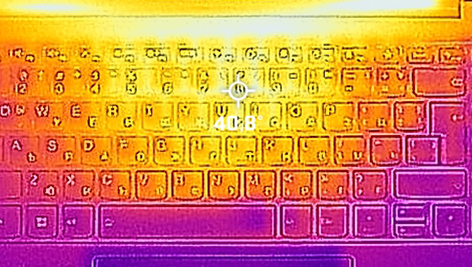
Verdict
 Lenovo has transformed the Yoga 9 into a really good machine. Last year, it was under-engineered, while now, it comes prepared with an adequate cooling solution. This enables the 15mm-thick notebook to perform on-point with Alder Lake-P CPUs.
Lenovo has transformed the Yoga 9 into a really good machine. Last year, it was under-engineered, while now, it comes prepared with an adequate cooling solution. This enables the 15mm-thick notebook to perform on-point with Alder Lake-P CPUs.
Some of its exquisite features include zero-touch lock and login, as well as video pause. You get a row of buttons on the keyboard, which give you control over the performance presets, sound, and visuals, as well as a neet function, which removes your background when you’re on a conference call.
Of course, this wouldn’t be possible if it wasn’t for the great Full HD Web camera, and the IR face recognition scanner. The Windows Hello feature is completed by a fingerprint reader (and the aforementioned IR sensor).
Lenovo Yoga 9i (14″, 2022)’s touchscreen OLED panel has a high resolution, comfortable viewing angles, and pretty much infinite contrast ratio. Its true blacks make images really pop, while the 100% DCI-P3 coverage brings all the colors to life. In addition, OLED technology has the huge benefit of almost instantaneous pixel response. This is why the 90Hz refresh rate feels smoother than 165Hz on some gaming machines.
One thing we found a bit short is the battery life. We got 7 hours of Web browsing or video playback. Yes, the included battery is big (75Wh), but apparently, the 28W chips and the OLED panel don’t help with that.
We were absolutely fascinated by the design. It has shiny sides, looking like chromed details. The chassis sports a super strong structure, and all this can be protected by the included sleeve. And yes, there is a stylus inside the box, although it might not be found in all configurations.
When it comes to the port selection, we just can’t hate the Yoga 9i (14″, 2022). It has two Thunderbolt 4 connectors, a USB Type-C 3.2 (Gen. 2), and a USB Type-A 3.2 (Gen. 2) port. Yes, there is no SD card reader, but the inclusion of a USB Type-A port makes up for it.
Unfortunately, the memory of this notebook is soldered to the motherboard. The maximum available configuration offers 16GB of LPDDR5 RAM, while the storage is handled by an M.2 PCIe x4 slot, and supports Gen 4 SSDs.
This machine is really good, and you won’t do wrong by choosing it. However, before you spend your Bitcoins, take a look at the HP Spectre x360 14 (14-ef0000).
You can check the prices and configurations in our Specs System: https://laptopmedia.com/series/lenovo-yoga-9i-14-2022/
Pros
- Strong and stylish aluminum chassis
- Decent cooling
- Full sRGB and DCI-P3 coverage
- Super-fast pixel response time
- Infinite contrast ratio
- High resolution and 16:10 aspect ratio
- IR camera + fingerprint reader
- 2x Thunderbolt 4 + USB Type-A 3.2 (Gen. 2)
- A protective sleeve and a stylus inside the box
Cons
- Soldered memory
- Average battery life
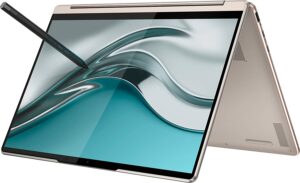


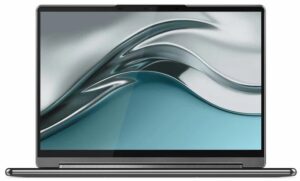
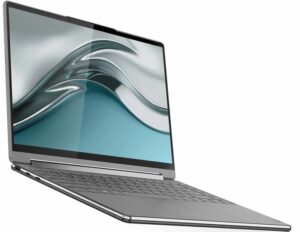
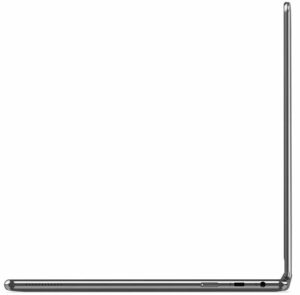
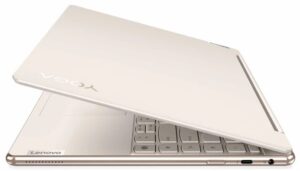
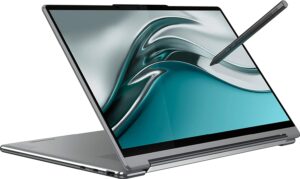
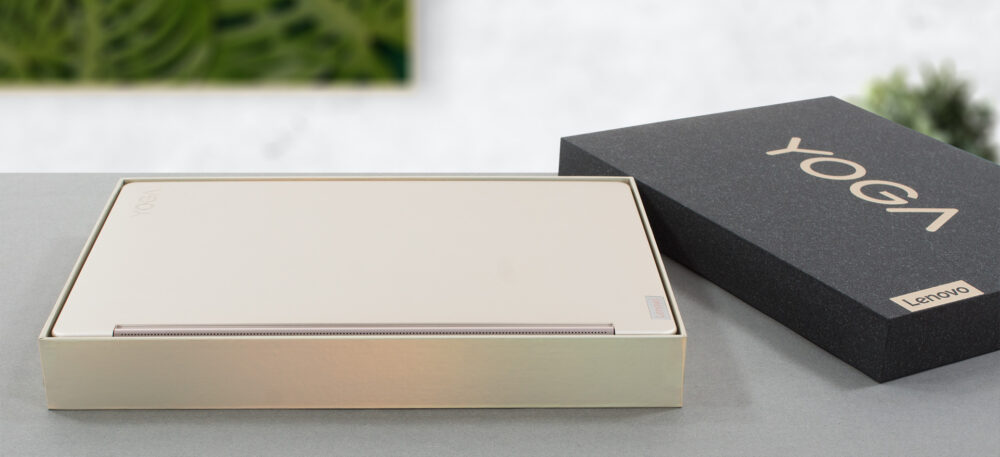
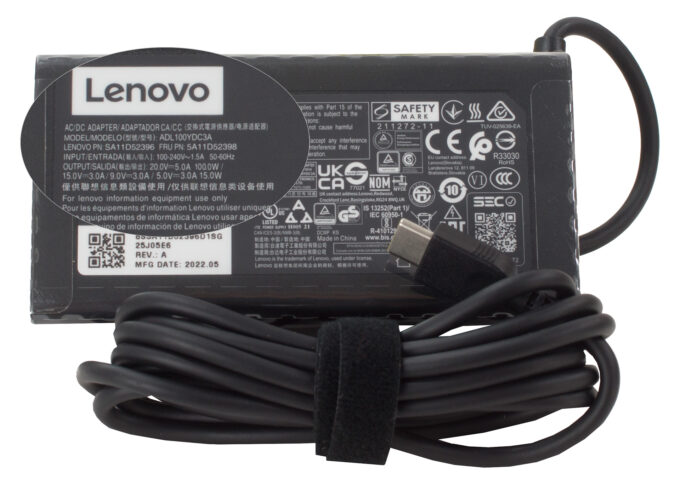
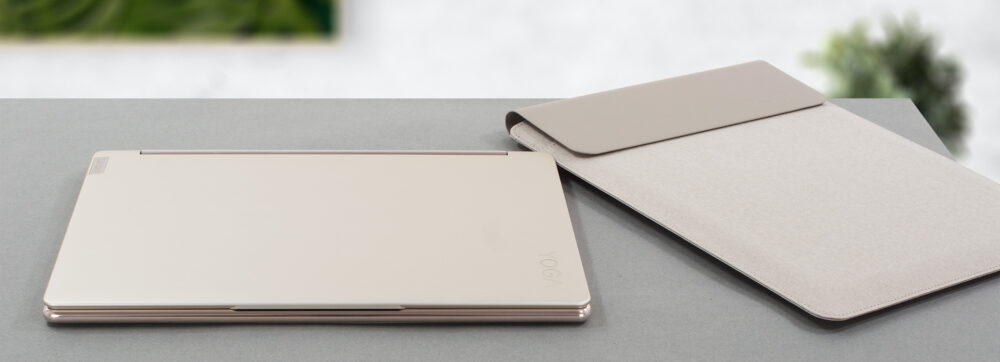
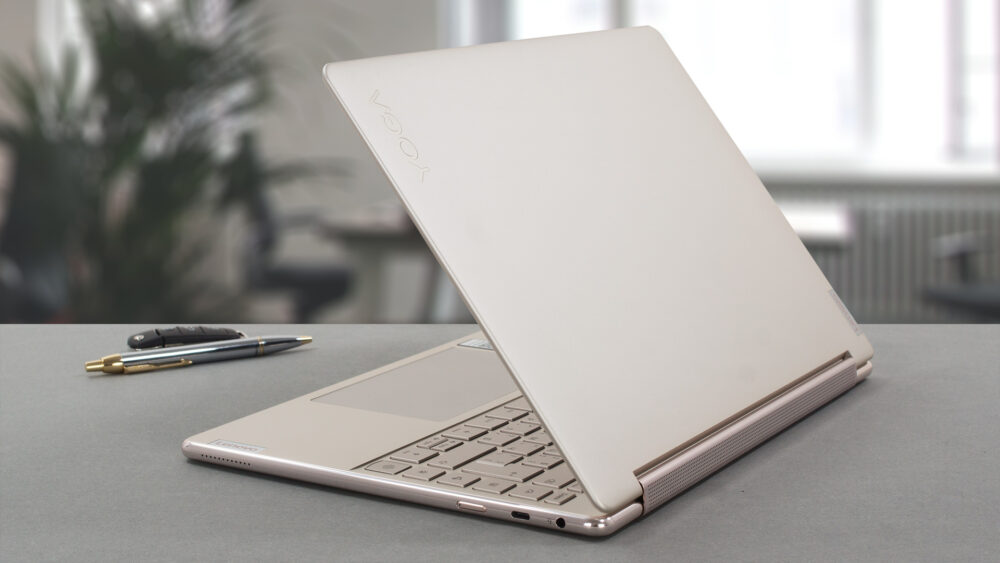
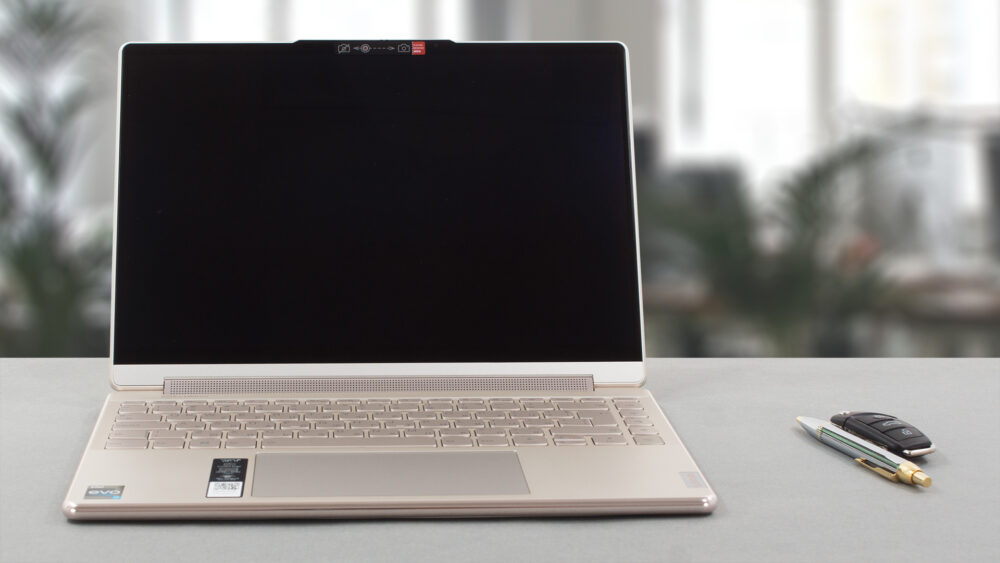
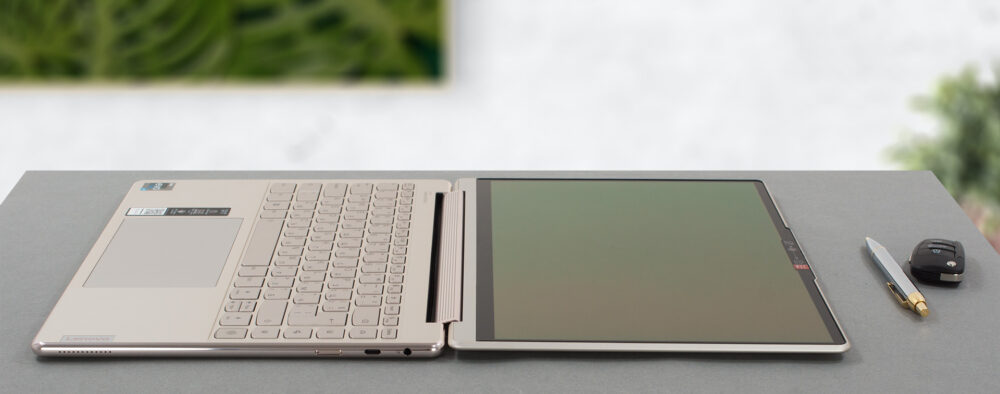
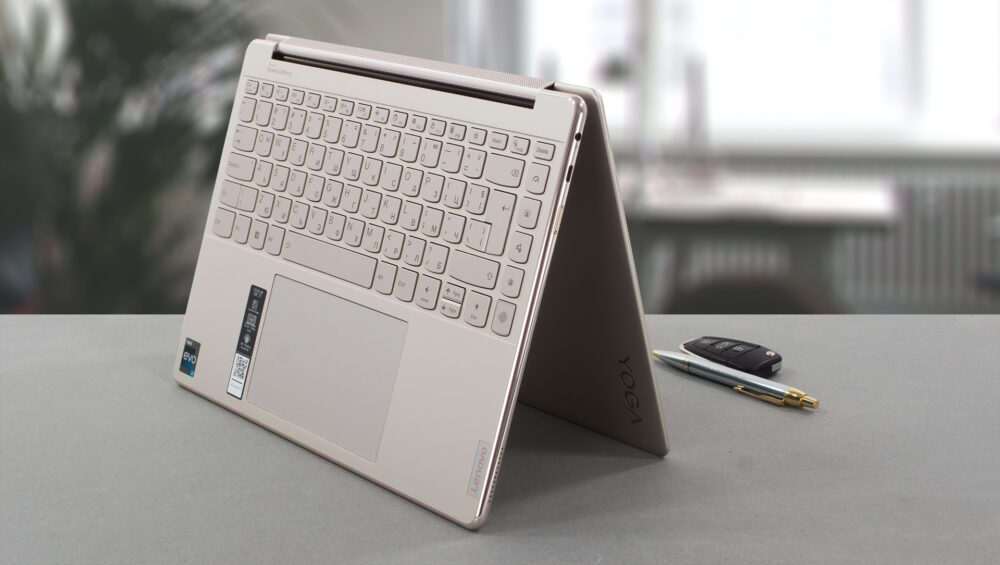
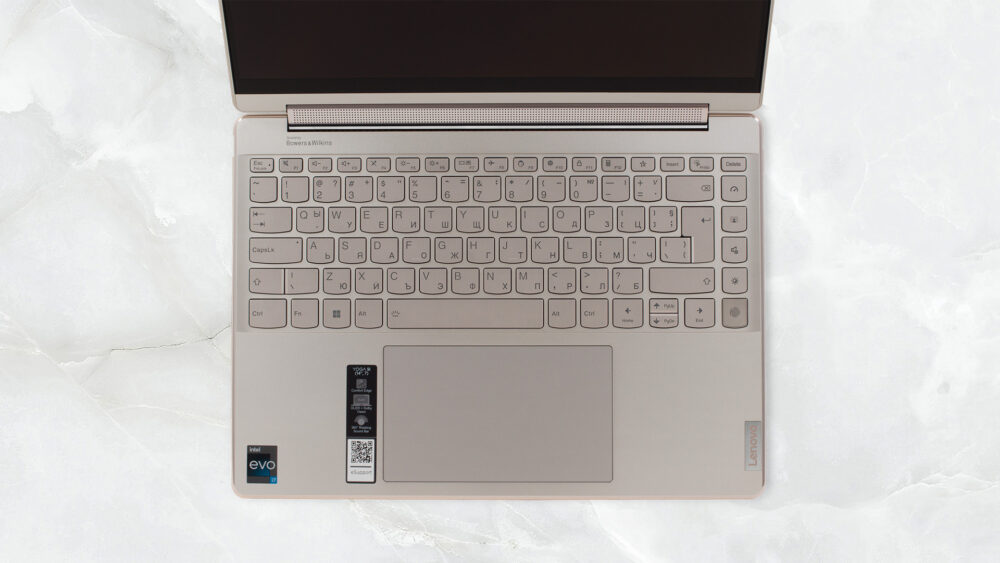
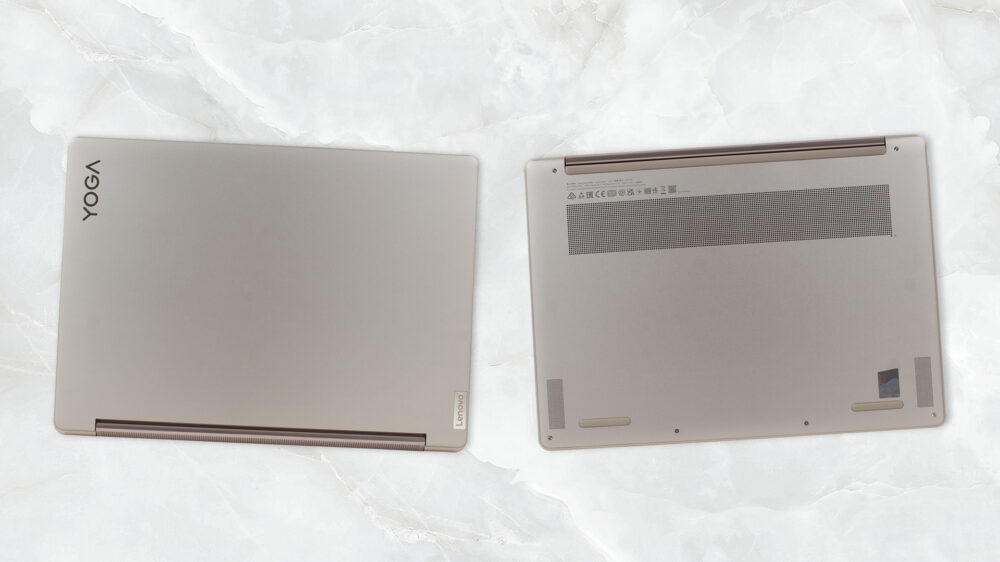


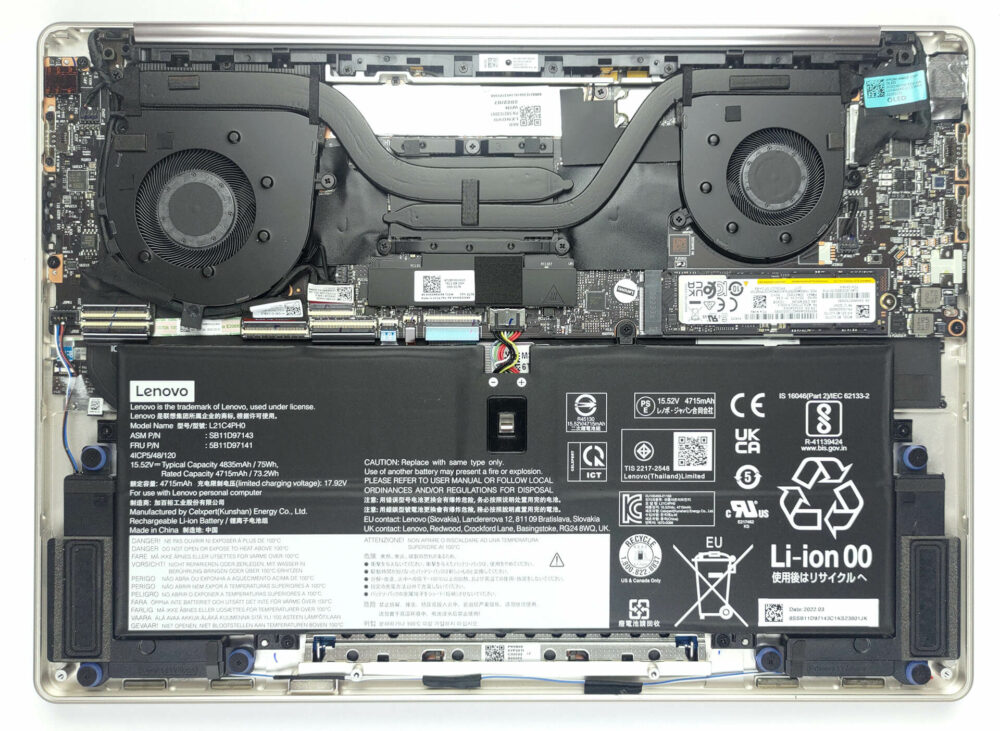
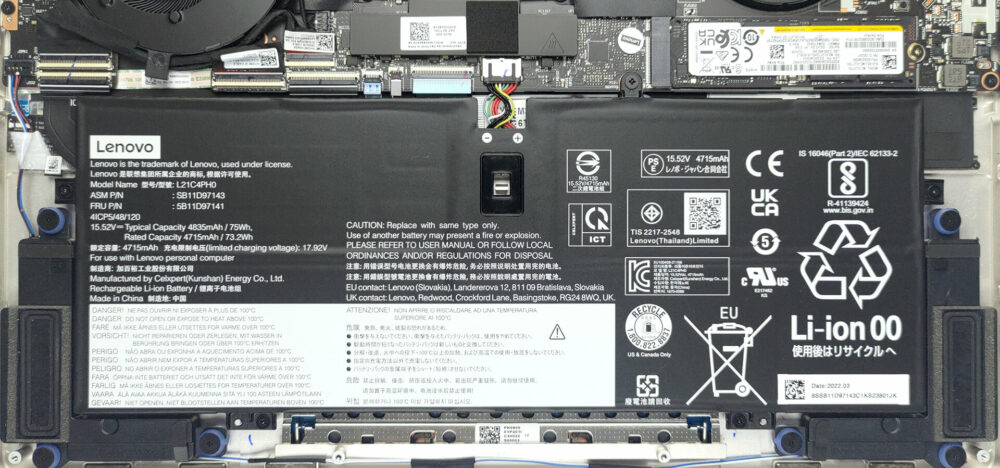
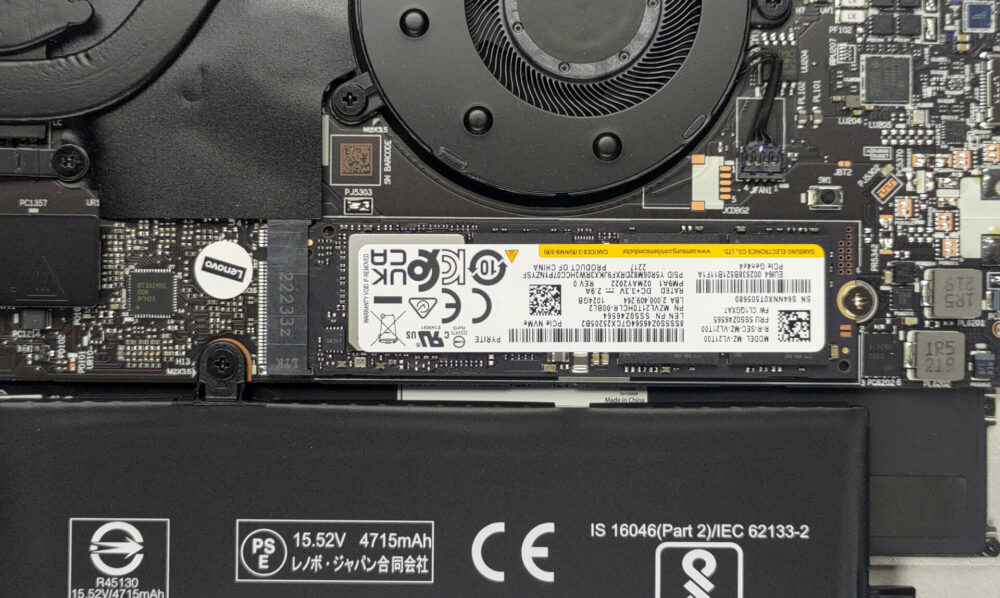



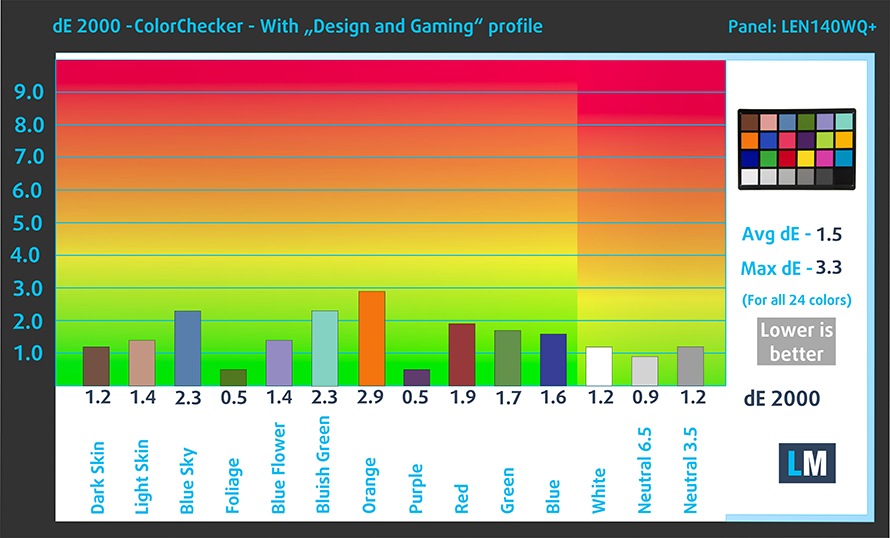
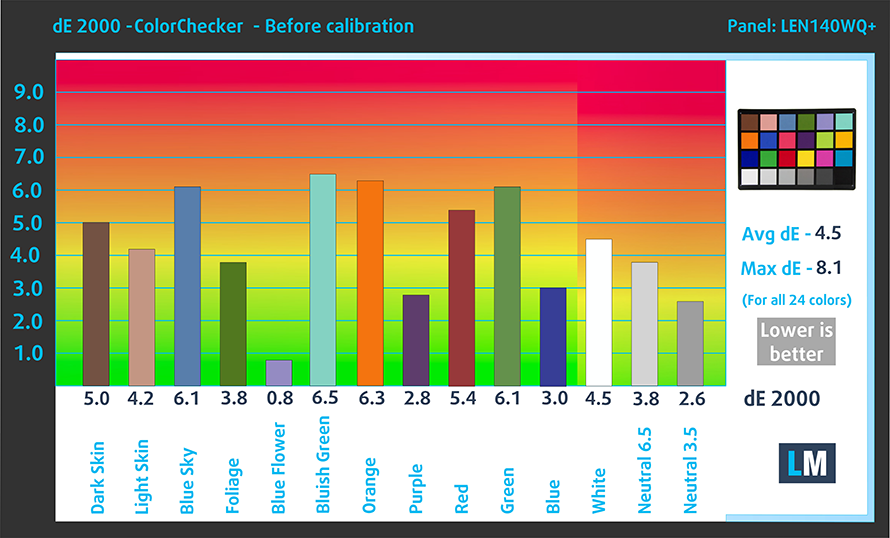


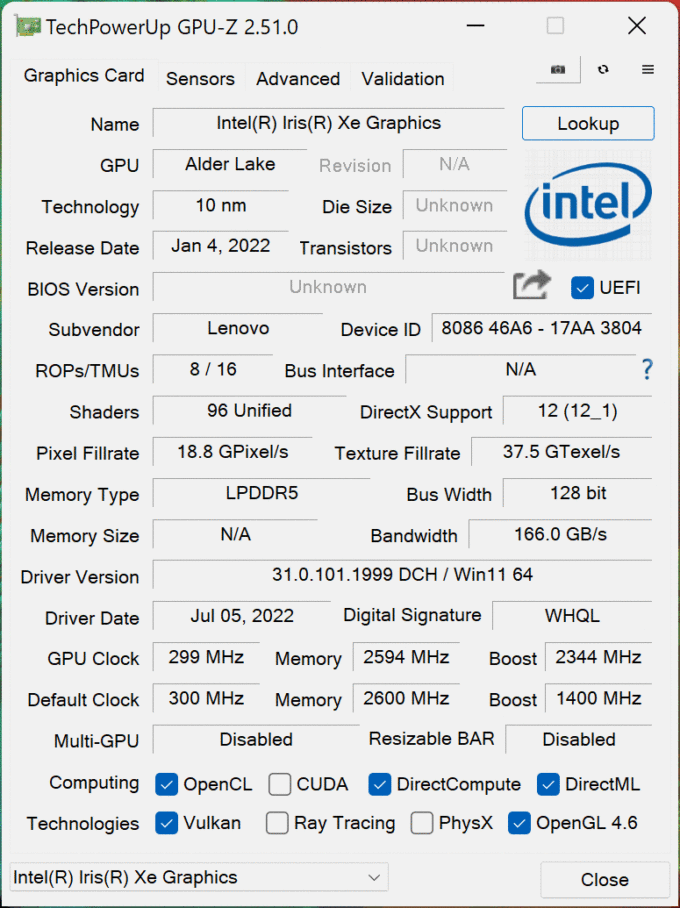








Comment to battery. Real life battery consumption conditions (mixed use of constant web-browsing, typing in word, checking and writing emails) are much worse than it looks from your review. In reality you have only max. 4 hours till battery drain to zero in saving mode, 3 hours in intelligent cooling mode and about 1:50 in performance mode. Its really tragic results. In fact Yoga 9 is totally unusable as mobile device. The results are so bad that Im surprise Lenovo even selling this machine.
What is surprising is that anyone would post such blatantly false information. 1. This laptop is Evol certified which requires 9 hours of battery life. 2. I get 11-12 hours watching YouTube with battery saver on, all background apps closed, and brightness at 50%. 3. This laptop has a 75 wh battery which is well above average for a 14 inch laptop. 4. In a very competitive global laptop market, who would sell (or buy) a laptop with 3 hours of battery life?
Greetings,
https://www.notebookcheck.net/Lenovo-Yoga-9i-14-2022-Laptop-High-End-Convertible-with-4K-OLED-in-Review.617690.0.html
this review says it does not have any PWM at 100% level
please help